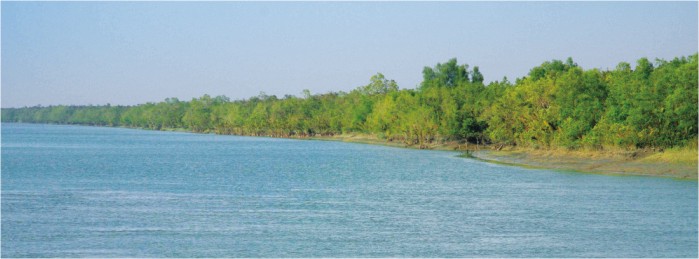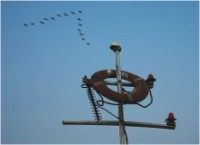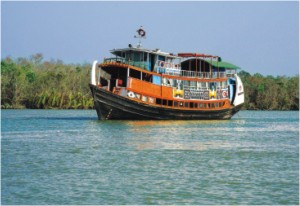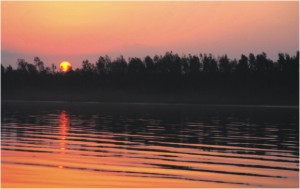The pale darkness was spread like a foggy filter across the horizon, through which the stealthy quietness of the night was beaconing me into the depth of the forest ruled by the Royal Bengal Tiger. Just when I was beginning to get inebriated by the serenity doused by chilled fresh wind on the River Poshur, a cock somewhere crowed out loud. And at that moment, as if on a cue, my photographer colleague Zakir popped his head out through the manhole door from the lower deck, "Have you heard the crowing of a wild rooster?" he asked enthusiastically climbing up on the top deck in front of the master bridge. We were on a pleasure trip to the Sundarbans with a group of 12 New Zealanders on invitation from Samatata Cruises, a touring company, on board its MLS Andharmanik, a motorized wooden bajra.
And luxury it was through three nights and three days of 24-hour attention from the crew, complete with round the clock availability of tea or coffee, attached tiled bathrooms with every cabin with complete western fittings, and sumptuous 5 meals a day, some of which were specially cooked with personal touch by our nature buff host himself. We started from Dhaka by bus on a late winter Sunday morning and boarded on the Andharmanik at Khulna Jail terminal in late afternoon, with golden yellow soft rays of the sun shining upon us on the Rupsa River. The Rupsa Bridge was accentuating the horizon behind us as we approached the bajra on two motorized country boats. Manju told me later that the Rupsa was originally a canal dug by a salt merchant Rup Saha during the early days of colonial rule to connect the Bhairab and Poshur rivers, but the canal turned into a river in only 50 years. A lesson in history at the beginning of the journey churned up my appetite for more.
We waited until sunset for an ebb in the river flow, to sail with ease towards the Sundarbans at the Bay of Bengal, as reflections of lights lining up the banks of the Rupsa were picturesquely dancing in a slow rhythm on the ripples of dark water. As we were going further downstream out of the city limits to get on the Poshur River towards the forest, the lights on the banks and their water dances became fainter and scantier. Nature was creeping onto us, and suddenly I found that my companions had already started to shed their city uptightness as they were milling around on the top and lower decks, much more relaxed, greeting and shaking hands with each other, getting acquainted. The nature had started working its magic on the passengers of the boat, I thought. Nights grow late quite fast in the wilderness, so it was dinner time soon. We went into the tank of the boat to find a nice dining room there, with rickshaw paintings adorning the wooden walls. We were served with a full course dinner of fresh fish, vegetable, beef, and daal with rice, and desert to follow, all in authentic desi style, giving rise to an instant murmur at the table about the prowess of the chef. After the dinner while most of the group were lingering at the dining table with tea and coffee in the bowl of the boat, I along with Zakir and Manju slipped out to the top deck at the bow end, sitting on a straw mat resting our bodies on cushy pillows as the boat pierced through the chilly night towards the horizon. We were already on the Poshur River, much wider than Rupsa. Traces of the city were now only discernible through distant flickering of lights, and the horizon was much wider with silhouettes of lush vegetation on both sides. The quietness wrapped in pale chilly darkness was almost surreal to a city guy like me. I suddenly realized none of the city hassles and haggles could bother me now, other than a few phone calls, which would also become impossible by the next morning, since there would be no network connection. I started to feel lighter.
Zakir had made a few other trips to the Sundarbans before, and he was on a high adrenaline to catch a tiger on film. His enthusiasm was contagious. "I and Bagh Khosru once erected a watch tower at Jamtola of Kotka and waited two nights to record tiger activities. But we had to return empty handed, because mama is one of the most elusive of creatures," Zakir shared with us an anecdote from the chest of his previous adventures, after a long day. Tigers are euphemistically called 'bagh mama' in Bangalee popular culture, meaning 'tiger uncle'. "Yeah, to really seriously stalk a tiger you have to be very methodical and have to be in a small group. Still most of the time you will probably not get a view of them in the wild, because they like to avoid contact with humans, unless they are desperate," Manju elucidated me about tiger behaviour. The Sundarbans is the only mangrove forest with the eponymous Royal Bengal Tiger. It is estimated that there are now 500 Bengal tigers and about 30,000 spotted deer in the Sundarbans, which covers 10,000 square kilometres (sqkm) of area straddling the border between Bangladesh and India, of which about 6,000 sqkm are in Bangladesh. There are some other numerous fauna in the Sundarbans including many species of birds, crocodiles, and snakes. The Sundarbans and the costal waters of Bangladesh are also home to the world's largest population of Irrawaddy dolphins. The word Sundarban literally means 'beautiful jungle' or 'beautiful forest' in Bangla, but the name might also have been derived from the Sundari trees that are found in that forest in large numbers. Manju had to go back to the tank to have the day's wrap up meeting with his crew, and Zakir was feeling sleepy. I was left alone at the front end of the top deck, soon to find that all lights except the moon had vanished, even the electricity generator on board had also been turned off after the dinner. The persistent low drone of the boat engine was the only sound audible. We finally left far behind, what we call modern civilisation. I inhaled the chilly fresh wind filling up my lungs and felt the nature on my skin.
It was getting late even for me, so I started going downward to the bunk bed I was to share with Zakir in a cabin on the lower deck. Manju had asked me not to forget bringing a flashlight with me on the trip, soon I found out why. As I descended on the lower deck and went into the cabin, I was engulfed by a total blackout, no way to move an inch without the flashlight, and I had still to change into my slumber clothing, hang the mosquito net, and also had to pay a visit to the loo, which was also in total darkness at that hour despite its shiny modern amenities. My flash light became my eyes, and I told myself, welcome to the life on a boat. As I was laying on the cozy lower bunk wrapped in a quilt, my eyes had already got used to the darkness in the cabin, and I found faint rays of moonlight sipping into the room through the thin cracks between the planks of the wooden wall, creating a dance of light and darkness keeping pace with the slow rhythm of the boat's float. I thought of the ghost stories of sea I had heard when I had been young, and of the brutal colonialists who had come to this land on ships voyaging through the seas for months and sometimes even for years, living a harsh life full of excruciating daily chores on board, to conquer and rule a foreign people. Ironically those were the very people who for the first time brought the Sundarbans under a safe management. Centuries later, a group of their descendants were sleeping in the adjacent cabins coming to visit the Sundarbans, from another far away country which had also been colonised, with permission from a sovereign government of the people some of their ancestors had brutally oppressed for 200 years. But our New Zealander companions seemed very nice and congenial, although the complexities of emotions could be felt lurking underneath the surface during conversations. Such is the cycle of civilisation, I thought before drowning in a deep slumber, after a long day full of physical activities. I did not dream that night. Courtesy
Story: Ahmed Ali Photos: Syed Zakir Hossain ©thedailystar.net 2008 |
||


 T
T "We decided to build a bajra to maintain the traditional form of luxury cruising and fused its design with more modern launches to give the weight necessary for heavy sailing around the bay. The zaminders of the colonial period used bajras for such luxury cruising, its feasibility is proven," said Manju, one of the two proprietors of the company.
"We decided to build a bajra to maintain the traditional form of luxury cruising and fused its design with more modern launches to give the weight necessary for heavy sailing around the bay. The zaminders of the colonial period used bajras for such luxury cruising, its feasibility is proven," said Manju, one of the two proprietors of the company.  But for now Manju shifted his attention to satiating our other kind of appetite, with a spicy snack of chanachur, sautéed Bengal chicpeas with sliced raw green chilli, julienne raw cucumber, onions and tomatoes, and tea or coffee, welcoming us on the top deck under a nicely decorated canopy as soon as we boarded the majestic looking boat.
But for now Manju shifted his attention to satiating our other kind of appetite, with a spicy snack of chanachur, sautéed Bengal chicpeas with sliced raw green chilli, julienne raw cucumber, onions and tomatoes, and tea or coffee, welcoming us on the top deck under a nicely decorated canopy as soon as we boarded the majestic looking boat.  A few mosquitoes were biting us and I was slapping them. "The mosquitoes that are biting you, we brought them with us in the boat. There aren't many mosquitoes in this part of the region, since the tides in the estuaries of the bay wash out the banks twice a day, leaving hardly any stagnant water for mosquitoes to breed," said Manju.
A few mosquitoes were biting us and I was slapping them. "The mosquitoes that are biting you, we brought them with us in the boat. There aren't many mosquitoes in this part of the region, since the tides in the estuaries of the bay wash out the banks twice a day, leaving hardly any stagnant water for mosquitoes to breed," said Manju.